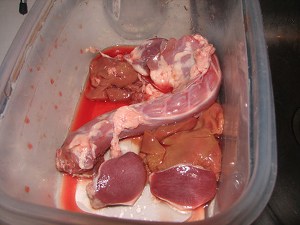
One of the great things, I think, about the raw food market for dogs is the huge range of meats that are available for dog owners to buy.
And that some of these “cuts” of meat, if they weren’t sold to dog or cat owners might simply be thrown away.
I like the idea that it is reducing waste- particularly from animals that have been killed.
Obviously I’m not talking about your pure chicken minces or 100% ox minces…
But I am thinking about parts of animals that most of us wouldn’t touch- even if we were paid to..
One of those less desirable animal parts are “necks” and I have already written an article answering the question “can dogs eat turkey necks?”
But in this article, I want to look at duck necks- are they something that we should be feeding to our dogs?
Let’s find out shall we?
What nutrition do duck’s necks contain?
Duck is no different from any other meat in that it is high in such nutrients as fat and protein.
To be more exact, a 100g portion of a duck’s neck would typically contain about 130 calories, 5g of fat and 19g of protein.
What is a bit weird is that those numbers mean that the nutrition in a duck’s neck is almost exactly the same as a turkey’s neck.
A turkey neck is nutritionally closer to a duck’s neck than a chicken’s neck- a topic that I will return to later on in this article.
Beyond the fat and protein, a duck’s neck will also provide some important vitamins and minerals to a dog.
Duck is high in vitamin B6 which like all the other B vitamins contributes to the health of the cells within a dog’s body.
Mineral- wise, copper is one of biggest minerals in duck meat and it plays an important part in creating healthy red blood cells within our dog’s bodies.
So having listed the nutritional pros and cons of eating duck necks, I next want to talk about the best way that they can be prepared for your dog.
Raw vs cooked vs dehydrated- which duck neck is safer?
Your three standard options are raw, cooked or dehydrated.
And none of these options are totally risk free.
Raw duck necks might contain harmful bacteria, whereas cooking the necks to kill the bacteria will also make the tiny bones which are inside the necks a choking hazard.
Dehydrated necks don’t need to be stored in the fridge or freezer which is convenient but because they are cooked and then dehydrated they come with all of the disadvantages of cooked duck necks.
Sorry if you were looking for a simple black and white answer then you are out of luck.
Firstly, I want to look in more depth at raw duck.
Did you know that duck is classed as poultry?
Which means that if you are thinking of feeding it raw to your dog, you need to realise that it might contain some harmful bacteria.
In this way, duck is in the same boat as chicken and turkey.
The bacteria to look out for in duck meat is campylobacter and the symptoms of this are diarrhea and fever.
And the only way to guarantee that there is nothing harmful in a raw duck neck is to cook it.
And that means cooking it until the temperature in the centre of the meat reaches 165 C.
Which to me is such a bummer!
I mean, raw is just so easy: it is so quick and creates so little mess.
Next up, I want to look at cooking duck.
And you don’t need a fancy recipe with lots of seasoning because your dog won’t appreciate all of the different flavours and some of them might poison your dog.
You just need the easiest way to cook the necks so that their internal temperature hits 165 C- which is the magic number at which the dangerous stuff is killed.
If the advantage of cooking a duck’s neck is that bacteria is snuffed out, the disadvantage is that the tiny neck bones become a far bigger choking hazard to a dog.
This is because cooking any type of animal bone makes it much harder which as far as neck bones are concerned means that they are more likely to get stuck in a dog’s throat than their raw counterparts.
Two options down, one to go.
So that just leaves us with the dehydrated option.
As I said earlier dehydrated duck necks are cooked necks which are then allowed to air dry.
And so the same concerns that we have over cooked necks remain for dehydrated necks.
This leaves me wondering if there is a price difference for these three different forms of duck neck.
Something that I will look at next.
How much does a duck neck cost?
On this site, four freeze dried duck necks will cost you $15.
And to be honest, I’m struggling to find a supplier for dehydrated duck necks in the U.S. but there are a few options for those of you living in the UK such as here and here.
You will pay about £6.50 for two dehydrated necks.
And how do they compare in price to raw duck necks?
Well this site is selling a pack of six raw duck necks for about £2.70.
If you are most concerned with price (perhaps more important than convenience) then it seems as if raw is your best option.
Having looked at all the different forms of duck necks that are available, in the next section I will look at how duck necks compare against other types of animal necks.
After all, duck necks aren’t the only necks available.
Chicken vs turkey vs duck necks: which are more nutritious?
Although the focus of the article is on duck necks, there are other animal necks which are available on sites that sell dog food.
And the two which are most commonly available are chicken necks and turkey necks.
But how do they compare nutritionally?
| 100 g serving | Duck Neck | Turkey Neck | Chicken Neck |
| Calories | 130 | 130 | 157 |
| Fat | 5 g | 6 g | 11 g |
| Cholesterol | 0 mg | 0 mg | O mg |
| Protein | 19 g | 20 g | 15 g |
As you can see from the chart, any differences between the three different neck meats are marginal.
In fact, as I noted earlier, duck and turkey are almost the same.
Chicken has about 25% more calories and almost double the fat content of the other two meats but it also has about 25% less protein in it.
With so little difference, you are free to choose any of these neck meats .
But what is availability like?
On the day that I wrote this article, the availability of these three types of animal necks was pretty good for people in the US,
But on this website, duck, turkey and chicken necks are all available.
Chicken necks are around $25, turkey necks $30 and duck necks $35.
Whereas this site only has chicken checks and duck necks.
The freeze dried chicken necks and duck necks both start at $12 for 4.
So if the odd turkey, chicken or duck neck is your dog treat of first choice, it seems as if you are well served.
Next, in a slight change of direction, I want to focus purely on duck necks and look at what happens if your dog swallows one whole.
My dog swallowed a duck neck whole
You what?!
You swallowed the whole neck?
I thought I said to chew it slowly.
The scene is like something out of a Tom and Jerry cartoon.
But some dogs will accidentally or deliberately swallow a whole duck’s neck.
And for a dog owner, this can trigger a minor heart attack.
This article has already mentioned the fact that duck necks contain little bones.
Now any bone has the potential to be a choking hazard to a dog because even when they are raw bones are hard objects.
If your dog has just got so over excited and swallowed a duck neck then they could land themself in a whole heap of trouble.
The simple fact is that duck necks are big objects- far bigger than most dog’s throats.
They are designed to be chewed, not swallowed.
But it isn’t only the bones that are a hazard.
Most of the meat in a turkey neck is muscle meat- the neck needs to be strong in order to balance the weight of the bird’s head.
Muscle meat is tough and full of sinew which makes it harder to swallow because it doesn’t break apart like other softer meats do.
The immediate danger of a dog swallowing a whole neck is that they might choke and the symptoms to be on the look out here are the obvious.
Choking, retching or vomiting hopefully with the happy end result being that the almost whole neck comes back up…
Importantly for you and your dog it will be crucial to not let it happen again.
And I will provide some hints on how to do this in a later section where I talk about puppies.
But next up, I want to talk about frozen necks.
Is it safe to feed frozen duck necks to dogs?
Most raw food that is delivered to your door in the UK and the US is delivered frozen and this includes raw treats such as turkey necks.
But the food isn’t delivered frozen because that is the best way of feeding it to dogs, it is delivered frozen because it is the best way to keep the food fresh.
And this begs the question about whether we can skip a step and feed these frozen treats to our dogs?
Should we bother about trying to defrost our frozen duck necks?
And, I would say that as tempting as it is, we should defrost the necks.
And this is for two reasons.
Frozen duck necks can be both a choking hazard and a treat that your dog could potentially break one of its teeth on.
And all of this talk of jeopardy leads me to my next point.
So if you shouldn’t feed your dog frozen necks, are fresh duck necks appropriate for puppies?
Let’s find out.
Are duck necks safe for puppies to eat?
I don’t think that there is anything wrong with feeding a puppy duck necks as long as it is done with care.
Age wise, I would say that 4 months is a good place to start: although other people say that puppies can be fed duck necks from as young as 10 weeks of age.
I was just giving a puppy more time to become familiar with its staple diet and for it’s digestion system a little more time to mature.
We all know how delicate the stomach of a puppy can be.
Apart from that my only other advice would be to cut the neck up into small chunks before you feed it to them.
This gives you the chance to feed them a smaller amount of neck (a whole neck might just be too much for some puppies) and it gives you the chance to observe how they eat it.
And the key thing to look out for is whether your puppy chews the meat or tries to swallow it whole.
Can a dog eat duck giblets?
Phew!
We have spent a long time looking at duck necks don’t you think?
But if you don’t “source” duck necks from your favourite online store and you instead buy a whole duck from a local store, then you might receive duck giblets- which are the neck, heart, gizzard (or stomach) and liver from the duck.
Traditionally, giblets are included when you buy birds such as duck, turkey or chicken so that they can be boiled up to help make the gravy.
But if you are looking at the giblets as very special dog treats, then you are in luck.
All of these are perfect for your dog to eat with a few considerations to bear in mind.
Number one, in order to be safe, just cook these parts.
Don’t be tempted to feed them raw.
And number two, just be aware that liver is a very rich meat because it contains so much iron and vitamin A- huge quantities of vitamin A.
But this shouldn’t be a problem if you are just feeding your dog the giblets from one turkey.
It just might be a problem if you have a freezer full of ducks left over from the Chinese New Year…





